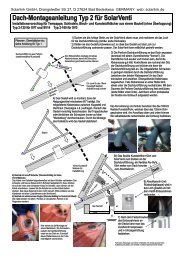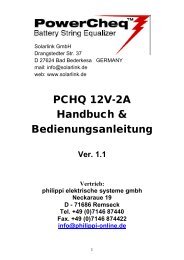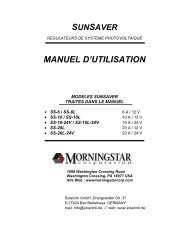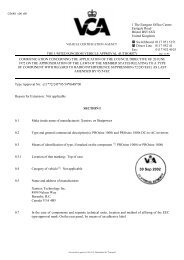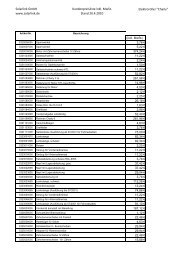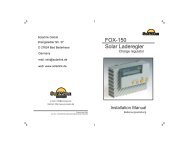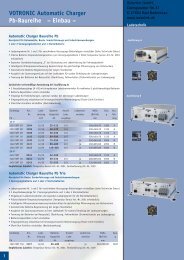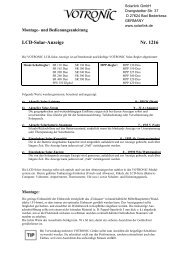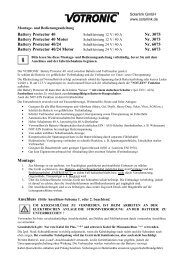The Alessi-Serie - Solarlink GmbH, preiswert und kompetent
The Alessi-Serie - Solarlink GmbH, preiswert und kompetent
The Alessi-Serie - Solarlink GmbH, preiswert und kompetent
Sie wollen auch ein ePaper? Erhöhen Sie die Reichweite Ihrer Titel.
YUMPU macht aus Druck-PDFs automatisch weboptimierte ePaper, die Google liebt.
<strong>The</strong> <strong>Alessi</strong>-<strong>Serie</strong><br />
Pure Sine Wave Inverters<br />
WARNING<br />
WHEN CONNECTING MORE THAN ONE APPLIANCE TO THE INVERTER,<br />
IN COMBINATION WITH A COMPUTER, NOTE THAT IF ONE OF THE<br />
APPLIANCES IS STARTING UP, IT CAN CAUSE YOUR COMPUTER TO<br />
REBOOT DUE TO A SUDDEN VOLTAGE DROP.<br />
2.8 Turning on the inverter<br />
When all the above requirements are checked and satisfied and all connections are made, it’s<br />
time to turn on your <strong>Alessi</strong> inverter by pushing the power switch in the ‘ I ’ position. After a short<br />
two tone beep, the sinewave shaped output voltage is gently rising until 230V/50Hz ± 1% (or<br />
115V/60Hz ± 1%) is reached, ready to power your appliances.<br />
When the inverter is not supplying power to an appliance for a longer time, it is recommended to<br />
use the inverter in Automatic Standby (ASB) mode to heavily reduce the inverter’s own power<br />
draw. In this case the power switch must be pushed in the ' II ‘ position. In ASB mode the inverter<br />
will generate a testpulse on it's output once per second, to check when there is a load applied.<br />
When the ASB mode is activated (by generating a reversed two tone beep), the blue AC Present<br />
LED will flash continuously for 4 seconds while the inverter outputs a continuous 230V (or 115V)<br />
sinewave. After this 4 seconds the continuous output will change to a pulsed output. Every time this<br />
pulse is generated the blue LED is activated too, in order to indicate that there’s a lethal AC voltage<br />
present at the output. When a load is connected to the inverter output (or switched on) drawing<br />
more than approx. 5W, the inverter jumps to the continuous mode immediately, delivering power<br />
to the load. When the load is disconnected again (or switched off) the blue LED starts flashing for 4<br />
seconds and the inverter jumps back to the pulsed output ASB mode. This way the inverter<br />
automatically jumps to a low power 'sleep' mode when there is no power demand on the output.<br />
Note that some loads like TV/video equipment (with standby mode) and alarm clocks need<br />
continuous power so that the ASB mode can not be used.<br />
With some small non compensated loads, it is possible that the inverter jumps from continuous<br />
output to pulsed output and vice versa all the time. In this case you have to connect a small<br />
additional load to the AC output.<br />
WARNING<br />
IF THE INVERTER JUMPED INTO AN ‘ERROR MODE’ (SEE CHAPTER 3.1)<br />
DUE TO AN OVERLOAD OR SHORT CIRCUIT, THE INVERTER WILL<br />
AUTOMATICALLY RESTART AFTER ABOUT 18 SECONDS.<br />
In case of a high temperature error, the inverter will automatically restart after it<br />
has reached an acceptable temperature. Right before the inverter will restart, it<br />
will warn you with a short beep.<br />
NEVER SERVICE THE AC CONNECTIONS WHEN THE INVERTER IS STILL<br />
RUNNING IN AN ERROR MODE!<br />
WARNING<br />
THE BUILD IN LARGE ELECTROLYTIC CAPACITORS CAN HOLD<br />
SIGNIFICANT DC VOLTAGE WHEN THE BATTERIES ARE<br />
DISCONNECTED.<br />
To avoid sparks or short inverter operation, it is advisable to switch on the<br />
inverter for 10 seconds after battery disconnection, before you transport the<br />
inverter.<br />
- 9 -




